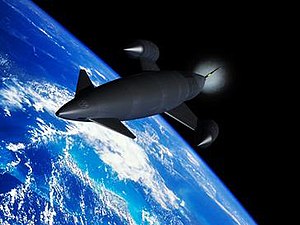Skylon (spacecraft)
| Skylon | |
|---|---|
 |
|
| The Skylon vehicle is intended to be an aircraft designed to reach orbit. | |
| Role | Re-usable spaceplane |
| National origin | United Kingdom |
| Designer | Reaction Engines Limited |
| First flight | 2025 - Proposed test flight |
| Status | Research and development |
| Program cost | Projected to be £7.1 billion (~$12 billion est. 2004) |
| Unit cost |
£190 million (projected)
|
| Developed from | HOTOL (Horizontal Take-Off and Landing) project |
Skylon is a design for a single-stage-to-orbit spaceplane by the British company Reaction Engines Limited (REL), using SABRE, a combined-cycle, air-breathing rocket propulsion system, potentially reusable for 200 flights. In paper studies, the cost per kilogram of payload carried to low Earth orbit in this way is hoped to be reduced from the current £1,108/kg (as of December 2015[update]), including research and development, to around £650/kg, with costs expected to fall much more over time after initial expenditures have amortised. In 2004, the developer estimated the total lifetime cost of the programme to be about $12 billion.
The vehicle design is for a hydrogen-fuelled aircraft that would take off from a purpose-built runway, and accelerate to Mach 5.4 at 26 kilometres (16 mi) altitude using the atmosphere's oxygen before switching the engines to use the internal liquid oxygen (LOX) supply to take it into orbit. Once in orbit it would release its payload (of up to 15 tonnes). The vehicle will be unpiloted, but also be certified to carry passengers. All payloads could be carried in a standardised container compartment. The relatively light vehicle would then re-enter the atmosphere and land on a runway, being protected from the conditions of re-entry by a ceramic composite skin. When on the ground, it would undergo inspection and necessary maintenance. If the design goal is achieved, it should be ready to fly again within two days.
...
Wikipedia
